
В данной статье приведён примерный перечень ископаемых переходных форм, то есть останков существ, которые демонстрируют примитивные черты по сравнению с наиболее развитыми представителями своего таксона. Окаменелости перечислены в определённой последовательности, показывая переход от одной таксономической группы к другой и представляя значительные шаги в эволюции основных черт живых организмов в различных эволюционных линиях. Эти изменения часто представляют собой серьезные изменения в анатомии, связанные с образом жизни, например, приобретение оперённых крыльев птицами или ног тетраподами. Как отмечал ещё Дарвин, палеонтологическая летопись страдает опеределённой неполнотой[1].
В идеале этот список должен включать в себя только «истинные» переходные окаменелости, представляющие прямых предков, из которых далее развились известные таксономические группы. Однако большинство представленных здесь находок являются вымершими боковыми ветвями, более или менее тесно связанными с настоящими предковыми видами[2]. Все они также включают уникальные черты, характерные для своих эволюционных линий. Ископаемые, демонстрирующие небольшое количество таких уникальных черт, называются «переходными». Если же ископаемое имеет множество уникальных черт, не наблюдаемых ни в предковых, ни в производных группах, оно определяется как «промежуточное». Поскольку все виды всегда подвергаются естественному отбору, сам термин «переходное ископаемое» не является корректным. Однако это часто используемый термин и полезная концепция в эволюционной биологии. Окаменелости, представленные в списке, отражают важные шаги в развитии основных функций организмов в различных эволюционных линиях и в этом смысле соответствуют общепринятой интерпретации этого термина.
От наутилоидей к аммонитам
править| Эволюционная линия Наутилоидеи?! → Аммониты?! | |||||
|---|---|---|---|---|---|
| Возраст (млн. лет) | Таксон | Отношения | Статус | Описание | Фото |
| >500 | Надотряд: | Файл:Silurian Orthoceras Fossilcro 2.JPG | |||
| 390 | Отряд: |
| |||
| 370 | Подкласс: |
|  | ||
| Эволюционная линия [[Головоногие] | |||||
|---|---|---|---|---|---|
| Возраст (млн. лет) | Таксон | Отношения | Статус | Описание | Фото |
| 296 | Род: | Самый ранний известный осьминог | |||
| 164 | Род: | Примитивный осьминог |  | ||
| 165–164 | Род: | Ранний Vampyromorphida[англ.]* | 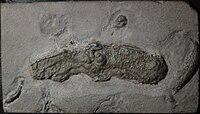 | ||
| 89-71 | Род: | Примитивный осьминог | Файл:Palaeoctopus newboldi.jpg | ||
| Эволюционная линия Насекомые | |||||
|---|---|---|---|---|---|
| Возраст, млн.лет | Таксон | Отношения | Статус | Описание | Фото |
| 400 | Род: | Древнейшее известное насекомое | |||
| 400 | Род: | Ранний springtail. | |||
| 300 | Род: | ||||
| 316.5 | Род: | Примитивный таракан | |||
| 140 | Род: | Древнейший известный Lepidopteran. | |||
| 92 | Род: | Древнейший известный вид пчёл | |||
| 80 | Род: | Древнейший известный вид муравьёв. | |||
| 56 - 34 | Род: | First leaf insect from the fossil record. | |||
| The Spider[англ.] | |||||
|---|---|---|---|---|---|
| Возраст, млн.лет | Таксон | Отношения | Статус | Описание | Фото |
| 390 | Род: | Долгое время считался древнейшим пауком | |||
| 165 | Род: | Древнейший известный haplogyne паук. | |||
От беспозвоночных к рыбам
править| Эволюционная линия Беспозвоночные → Рыбы | |||||
|---|---|---|---|---|---|
| Возраст, млн.лет | Таксон | Отношения | Статус | Описание | Фото |
| 523 | Род: | Ланцетникоподобное животное. Древнейший известный предок позвоночных Черты позвоночных:
| |||
| 504 | Class: | Имел лучи плавников, мышцы в форме шеврона и хорду |  | ||
| 530 | Род: | Предположительно имел череп и, таким образом, относился к черепным[3] |  | ||
| 480–470 | Род: | Бесчелюстная рыба | Хорошо бронированная бесчелюстная рыба, похожая на большого головастика |  | |
| 422-412 | Род: | Анапсида, предок челюстноротых[4] | Беспанцирная чашуйчатая бесчелюстная рыба |  | |
| 419 | Род: | Древнейшая известная костная рыба[5] | 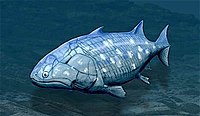 | ||
| Эволюционная линия Хрящевые рыбы | |||||
|---|---|---|---|---|---|
| Возраст, млн.лет | Таксон | Отношения | Статус | Описание | Фото |
| 370 | Род: | Ранняя примитивная акула |  | ||
| 70 - 65 | Род: | Ранний пилорылый скат | |||
| 99 – 65 | Род: | Ранний скат. | Файл:Cyclobatisjor 1.JPG | ||
| Эволюционная линия Костные рыбы | |||||
|---|---|---|---|---|---|
| Возраст, млн.лет | Таксон | Отношения | Статус | Описание | Фото |
| 420 | Род: | Древнейшая известная Actinopterygiian. | |||
| ??? | Род: | Ранний предок камбалообразных, один глаз смещён к центральной линии тела |  | ||
| 48 – 37 | Род: | Древнейшая известная настоящая камбала | |||
| 183.7–125.0 | Род: | Одна из первых костистых рыб. |  | ||
| 99 – 93 | Род: | Древнейший известный угорь. | |||
| 13 | Род: | Один из древнейших известных морских коньков |  | ||
| 13 | Род: | Один из древнейших известных морских коньков |  | ||
| 83 - 70 | Род: | Древнейший известный lamprid fish |  | ||
| 56 - 34 | Род: | Примитивный sunfish | |||
| 58 - 55 | Род: | Древнейший известный member of the catfish family Callichthyidae. |  | ||
| 56 - 34 | Род: | Примитивный rabbitfish. | |||
| 48 - 37 | Род: | Примитивный perch |  | ||
| 58 - 55 | Род: | Примитивный pomfret |  | ||
| 48 - 40 | Род: | An early handfish | |||
| 48 - 40 | Род: | Древнейший известный ostraciid boxfish |  | ||
| 48 - 40 | Род: | Древнейший известный aracanid boxfish |  | ||
| 48 - 40 | Род: | A basal surgeonfish | |||
| 48 - 40 | Род: | Примитивный monodactylid moonyfish |  | ||
| 48 - 40 | Род: | Примитивный monodactylid moonyfish |  | ||
| 48 - 40 | Род: | A short-snouted ancestor of the modern Moorish Idol. | |||
| 83 - 65 | Род: | Примитивный member of the Tetraodontidae | |||
| 83 - 65 | Род: | Примитивный Perciforme | |||
| 58 - 55 | Род: | Примитивный member of the Zeidae | |||
| 58 - 55 | Род: | Примитивный member of the Zeidae | |||
| ??? | Род: | Примитивный member of the Ichthyodectidae |  | ||
| 65 | Род: | Примитивный tetraodontid | |||
| Эволюционная линия Fish?! → Tetrapods[англ.] | |||||
|---|---|---|---|---|---|
| Возраст, млн.лет | Таксон | Отношения | Статус | Описание | Фото |
| 416-359 | Род: | An early member of the Tetrapodomorpha, the piscine line leading to tetrapods, Osteolepis?! is generalised enough to give a fair approximation of the common ancestor of tetrapods and lungfish.[6] | Fish | A small to medium sized sarcopterygian fish with internal nostrils and pectoral fins stiffened by bony components broadly homologous to the humerus and radius/ulna found in tetrapods.[6] | Файл:Osteolepiscrolepidotus.jpg |
| 385 | Род: | Belonging to the family Tristichopteridae, a family that form a sister group to Panderichthys[англ.] and the tetrapods.[6] | Though not on the evolutionary path to tetrapods, Eusthenopteron is of fairly general build and is very well known, serving as an iconic model organism in tetrapod evolution.[7] | A medium sized,inly pelagic fish, Eusthenopteron[англ.]*inly use the pectoral and pelvic fins for navigation, and the tail for propulsion.[7] The fin was of diphycercal, foreshadowing the straightening of the spine and the evolution of a contiguous fin in fish like Panderichthys[англ.] |  |
| 380 | Род: | Very close to the origin of tetrapods, a "fishapod" elpistostegalian.[6] | Fish | A large, predatory shallow water fish. As common in shallow water fish, the pectoral and pelvic fins were flexible and paddle-like for propulsion.[8] The dorsal and anal fins are lost, the tail fin contiguous.[9] The spiracles were short and wide, indication large amount of oxygen were taken up by the lungs rather than through the gills.[10] |  |
| 375 | Род: | A "fishapod" more tetrapod-like than Panderichthys[англ.].[6] | A fish, transitional between fish and the early, fish-like labyrinthodonts.[11][12] | "Fish" with stout, fleshy pectoral fins with a joint between the innermost and the two next bony elements, corresponding to the elbow in higher tetrapods. The cleithrum bone was free of the skull, functioning as anchoring for the pectoral fins, and at the same time allowing for movement of the neck.[12][13] | 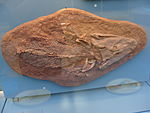 |
| 368 | Род: | Analysis of the cranialterial shows it was more advanced than Tiktaalik[англ.]*, and together with Obruchevichthys[англ.] form a sister group to the higher tetrapods.[14] | A fairly fragmentary find, Elginerpeton straddles the fish/tetrapod divide with a mosaic of features resembling Panderichthys[англ.], Ichthyostega[англ.]* and Hynerpeton[англ.]*.[14] Probably one of the "fishapods".[15] | Though fragmentary, the find includes a shoulder blade (Cleitrum bone) as well as elements of the limbs, which shows it had comparable limbs Ichthyostega[англ.]* and Hynerpeton[англ.]*, indicating feet rather than fins. |  |
| 365 | Род: | Known only from fragmentary remains, mostly a lower jaw, Ventastega is morphologically midway between Tiktaalik[англ.]* and Acanthostega[англ.]*/Ichthyostega[англ.]*.[16] | Possibly oldest animal to have feet rather than fins.[16] | A large, dorso-ventrally flattened predatory fish with a well armoured labyrinthodont-like skull. While the fins themselves has not been found, the shoulder girdle is essentially similar to that of Acanthostega, indicating it too had feet rather than fins.[16] |  |
| 365 | Род: | Together with Ichthyostega[англ.]* the sole early labyrinthodont known from fairly complete skeletons. It is the oldest animal known to have feet rather than fins, thusking it a true tetrapod and Древнейший известный unquestionable ichthyostegalian.[17] | First known animal with toes rather than fins. The feet were broad and paddle-like, adapted for movement in water.[18] It retained functional gills in adulthood, behind a fleshy operculum. |  | |
| 365 | Род: | Fairly closely related to Acanthostega[англ.]*. It possibly represent an early (and ultimately unsuccessful) line adapted to moving on land by inchworm-like movements. | Together with Acanthostega the sole early labyrinthodont known from fairly complete skeletons. | Early labyrinthodont with polydactylous, paddle-like feet and reinforced vertebrae and neural spines. It probably spent time on land, yet retained gills and a tail with fin rayes. |  |
| 360 | Род: | While known only from fragmentary remains, it is more advanced than Ichthyostega[англ.]*. | Early labyrinthodont amphibian | A large, basically salamander-like creature. The shoulder girdle was powerful, indicating it was a competent walker.[19] |  |
| ??? | Род: | An advanced ichthyostegalian, it straddle the divide between the fish-like Devonian forms and the more advanced Carboniferous amphibians. It has been suggested it is an early reptil-like amphibian.[20] | A large animal with paddle-like six-toed feet. It did however not have gills in adulthood, and is thus the oldest labyrinthodont known to depend entirely on breathing with its lungs.[21] |  | |
| 359 - 345 | Род: | Hailing from the fossil-poor Romer's Gap, Pederpesy be ancestral to the higher labyrinthodonts. | Intermediate between the earlier Ichthyostegalian and the later, more advanced labyrinthodonts. | Despite an extra toe on the forelimbs, Pederpes had limbs that terminated in feet adapted primarely for walking rather than paddles for combined swimming and walking like the earlier groups.[22] |  |
| 295 | Род: | The Temnospondyli are derived paleozoic amphibians, possibly ancestral to modern amphibians | A "classical" temnospondyl, an advanced labyrinthodont group. | One of the best known labyrinthodonts, Eryops combines the large, flat skull and short limbs typical of the group. |  |
| Эволюционная линия Labyrinthodontia[англ.]* → Lissamphibia[англ.]* | |||||
|---|---|---|---|---|---|
| Возраст, млн.лет | Таксон | Отношения | Статус | Описание | Фото |
| 290 | Род: | Colloquially referred to as a "frogamander" due to this taxon being both chronologically and morphologically basal to both anurans and salamanders | Идин из первых transitional fossils towards modern amphibians (Lissamphibia).[23] | Primitive traits
Derived traits
| |
| 250 | Род: | Intermediate between generalized amphibians and derived frogs | Early "almost frog" transitional amphibian | Primitive traits
Derived traits
| |
| 190 | Род: | Another transitional form which could be properly classified as a frog | An intermediate form whichy replace Triadobatrachus as the "ultimate" ancestor of anurans | Primitive traits
Derived traits
|  |
| 213-188 | Род: | A derived fossil frog completing the series of transitional fossils between early amphibians and modern anurans | The oldest "true" frog[24] | Primitive traits
Derived traits
| |
| 210 | Род: | Intermediate between basal amphibians and caecilians | An early caecilian | Primitive traits
Derived traits
| |
| Эволюционная линия Amphibians[англ.] → Reptiles[англ.] | |||||
|---|---|---|---|---|---|
| Возраст, млн.лет | Таксон | Отношения | Статус | Описание | Фото |
| 326 - 318 | Род: | One of the early reptile-like amphibians | Amphibian | A large, somewhat lizard-like labyrinthodont with a deep skull, laterally placed eyes and five digits to each foot. |  |
| ??? | Род: | The order Diadectomorpha is the sister group of the amniotes. | The Limnoscelis was originally described as a "cotylosaur" (early reptiles) together with the other diadectomorphans. Today the large-bodied diadectomorphs are thought to have had a larval stage, falling close to, but just outside the amphibian/reptile divide. | A large, predatory reptile-like amphibian. The limbs are extremely heavily built, indicating it fed on slow moving prey. |  |
| ??? | Род: | Uncertain phylogeny, possibly a Seymouriamorph or Diadectomorph[25][26] | Amphibian | A medium sized, probably herbivorious animal |  |
| 350 | Род: | Uncertain phylogenetic position. Westlothianay be a small-bodied diadectopmorph, falling just outside the amphibian/reptile divide | Originally described as the first reptile, it is now considered an advanced reptile-like amphibian. | Small, probably insectovorious animal. The body and tail was long, the limbs small, somewhat like a modern skink. |  |
| 320-305 | Род: | Possibly allied to the Diadectomorpha, or belonging to a sister group to Diadectomorpha and Amniota[27] | Likely an amphibian[27] | Smallish, likely carnivorious.[28] |  |
| 340 | Род: | The fragmentary nature of the fossil (it lacks a cranium)kes an exact phylogenetic position hard to establish. | Possibly the first animal with an amniote egg, and thus the first reptile. | Small lizard-like animal, the first known tetrapod to possess claws, indicating it has reptilian type skin with scutes.[29] |  |
| 315 | Род: | One of several small, basal reptile genera | Reptile | An early anapsid reptile, considered to be ancestral to both the synapsid and sauropsid lines, and thus the oldest representative of the crown group amniotes. |  |
| 312 - 304 | Род: | One of several small, basal reptile genera | Reptile (most likely a sauropsid) | An early anapsid reptile. In phylogenetic analysis it falls on the sauropsid side, it is thus likely a progenitor of the diapsids |  |
Черепахи
править| Эволюционная линия Turtle?! | |||||
|---|---|---|---|---|---|
| Возраст, млн.лет | Таксон | Отношения | Статус | Описание | Фото |
| 220 | Род: | Древнейший известный turtle. | |||
| 210 | Род: |  | |||
| 164 | Род: | An evolutionary bridge between early land turtles and sea turtles. | |||
| Эволюционная линия Lizard?! → Snake?! | |||||
|---|---|---|---|---|---|
| Возраст, млн.лет | Таксон | Отношения | Статус | Описание | Фото |
| 92 | Род: | A transitional form between Cretaceous lizards and limbless snakes retaining distinct, if non-functional, legs.[30] |  | ||
| 90 | Род: | A basal snake with two hind-limbs. | |||
| The Lizard?! | |||||
|---|---|---|---|---|---|
| Возраст, млн.лет | Таксон | Отношения | Статус | Описание | Фото |
| 61 - 58 | Род: | Древнейший известный chameleon. | |||
| 92 | Род: | A basal mosasauroid from the Upper Cretaceous of North America. | |||
| 71 - 82 | Род: | One of the earliest Varanoidea. | |||
| 146–100 | Род: | An primitive iguanid | |||
| 97–100 | Род: | Древнейший известный gecko | |||
| Rhamphorhynchoidea[англ.] → Pterodactyloidea[англ.]* | |||||
|---|---|---|---|---|---|
| Возраст, млн.лет | Таксон | Отношения | Статус | Описание | Фото |
| 160 | Род: | Basal to both rhamphorhynchoids and pterodactyloids |  | ||
| 160 | Genus | ||||
| Эволюционная линия Archosauria[англ.]* → Dinosauria[англ.]* Series | |||||
|---|---|---|---|---|---|
| Возраст, млн.лет | Таксон | Отношения | Статус | Описание | Фото |
| ??? | Род: | Древнейший известный archosaur, Proterosuchus was one of the largest land reptile during the Early Triassic, about the size of to today's Komodo dragons. It looked somewhat crocodile-like, with sprawling legs, long jaws, powerful neck muscles and a long tail. A distinct proterosuchid trait is the peculiar hook-shaped mouth. | |||
| ??? | Род: |  | |||
| ??? | Род: | Древнейший известный animal on the dinosaur/pterosaur side of the archosaurian tree (the Ornithodira), dating to about 245 million years ago.[33] | A small, lightly built animal. It had a fairly long neck (contrary to the short necked relatives of crocodiles), but ran on all four legs. |  | |
| ??? | Род: | Known from a somewhat fragmentary find, Spondylosoma was possibly an early dinosaur, or near dinosaur.[34] It has however also been classified as a rauisuchian.[35] | |||
| 228 | Род: | A very early representative of the sauropod stem line or perhaps even the Saurischia as a whole.[36][37][38] | A small (1 meter, ~ 10 kg) bipedal carnivore with numerous sharp teeth. It was a swift digigrade runner. The forelimbs were half the length of the hindlimbs and the hands had five fingers |  | |
| Эволюционная линия Dinosauria[англ.]* | |||||
|---|---|---|---|---|---|
| Возраст, млн.лет | Таксон | Отношения | Статус | Описание | Фото |
| 228 to 216.5 | Род: | Древнейший известный ornithischian. | 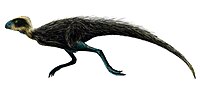 | ||
| 216–200 | Род: | The most primitive well-known representative of the sauropodomorph dinosaurs. |  | ||
| ??? | Род: | The oldest and most primitive known stegosaur. |  | ||
| ??? | Род: | A basal pachycephalosaur from the Barremian Stage of the Cretaceous. | |||
| 160 | Род: | A genus of basal ceratopsian dinosaur from the Late Jurassic Period of central Asia. |  | ||
| 160 | Род: | A genus of proceratosaurid tyrannosauroid dinosaur, one of Древнейший известный examples of the lineage. |  | ||
| 126 | Род: | An early genus of therizinosaur |  | ||
| 208–194 | Род: | One of the most primitive thyreophorans. |  | ||
| 130–125 | Род: | A possible ancestor of the duck-billed dinosaurs. |  | ||
| ??? | Род: | Примитивный (basal) ornithomimosaur. | |||
| Эволюционная линия Динозавры → Птицы | |||||
|---|---|---|---|---|---|
| Возраст, млн.лет | Таксон | Отношения | Статус | Описание | Фото |
| 152-151 | Род: | Primitive traits
Derived traits
| 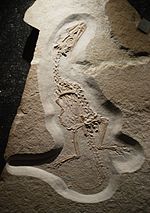 | ||
| 168-152 | Род: | The find is represented only by a hind leg, but one that is very bird-like. It belonged to a small maniraptoran dinosaur with long, pennaceous feathers on its hind legs and (in all likelihood) arms. | |||
| 161-151 | Род: | Basal troodontid | Although once classified as a bird, Anchiornis is now considered a basal troodontid which bears pennaceous, symmetrical feathers on all four limbs. | Primitive traits
Derived traits
|  |
| 150–145 | Род: | Known for its mosaic of avian and theropod characteristics Archaeopteryx is both the first primitive bird in the fossil record and Идин из первых transitional fossils discovered. | Traditionally seen as the first proper bird, though it is not directly ancestral to modern birds.[39] An excellent intermediate form between dinosaurs and birds. Capable of gliding, but lacking alula and keel, it could likely not sustain powered flight. | Primitive traits
Derived traits
|  |
| 120 | Род: | Found in the famous Liaoning province Confuciusornis is the first primitive bird with a pygostyle. | With its short tail and toothless beak, Confuciusornis is very modern looking compared to Archaeopteryx[англ.]*. The toothless beak is however a case of convergent evolution, as more advanced birds retained teeth, illustration the sometimes confusing mosaic evolution of the dinosaur-bird transition. | Primitive traits
Derived traits |  |
| 115 | Род: | Primitive bird and possibly a descendant of "urvogels" like Archaeopteryx. First bird to possess an alula. | Plesiomophic traits
Derived traits
| ||
| 93.5-75 | Род: | Considered a close relative to the ancestor to modern birds | A flying bird found in several epochs in the late Cretaceous which still bore teeth, but in most respects very similar to Neornithes. | Primitive traits
Derived traits
|  |
Bird evolution
править| Эволюционная линия Bird[англ.]* | |||||
|---|---|---|---|---|---|
| Возраст, млн.лет | Таксон | Отношения | Статус | Описание | Фото |
| 60-58 | Род: | The earliest-known Penguin. |  | ||
| ??? | Род: | An early фламинго. | |||
| ??? | Род: | An early gaviiform. | |||
| 55-48 | Род: | An early psittacine. | |||
| ??? | Род: | A basal falconiform. | |||
| 50 | Род: | An early apodiform. | |||
Синапсиды ("mammal-like reptiles") to млекопитающие
править| Эволюционная линия Синапсиды → Млекопитающие | |||||
|---|---|---|---|---|---|
| Возраст, млн.лет | Таксон | Отношения | Статус | Описание | Фото |
| ??? | Род: | Known from very fragmentary finds, Protoclepsydropsy be the earlies synapsid (mammal-like reptile) | A low-slung, lizard-like animal of moderate size. | ||
| 306 | Род: | The oldest undisputed synapsid (mammal-like reptile) | Primitive traits
Derived traits
|  | |
| 297 | Род: | Примитивный member of the Sphenacodontidae, or possibly just outside the group.[41][42] | A pelycosaur-grade synapsid | Derived traits |  |
| 265 | Род: | An advanced member of the family Sphenacodontidae, from which the therapsids (advanced synapsids) evolved | A pelycosaur-grade synapsid. At up to 4 meters, Dimetrodon was one of the largest animals of its time. The distinct sail of the backkes it the most recognized synapsid known | Primitive traits
Derived traits |  |
| 267 | Род: | Примитивный therapsid. About the size of a large dog, Biarmosuchus was a lightly built and likely fairly agile animal for its size.[46] | Primitive traits
Derived traits |  | |
| 248-245 | Род: |  | |||
| 205 | Род: |  | |||
| 125 | Род: | An early crown groupmmal. |  | ||
| Эволюционная линия Млекопитающие | |||||
|---|---|---|---|---|---|
| Возраст, млн.лет | Таксон | Отношения | Статус | Описание | Фото |
| 100–104 | Род: | Древнейший известный monotreme. | |||
| 125 | Род: | The oldest metatherian known. |  | ||
| ?? | Род: | The earliest-known marsupial. |  | ||
| 164-165 | Род: |  | |||
| 63-50 | Род: | Древнейший известный proboscidean. | |||
| 60-55 | Род: | The possible ancestor of the modern order Carnivora. | 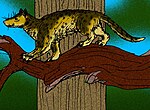 | ||
| 15.97–11.61 | Род: | Древнейший известный cervid. |  | ||
| 20-18 | Род: | Древнейший известный bovid. |  | ||
| 45-40 | Род: | The oldest верблюд known, it was also the smallest. | |||
| ??? | Род: | Suspected to be the ancestor of modern tapirs and rhinoceroses. |  | ||
| 55.4—48.6 | Род: | Suspected to be the ancestor of modern tapirs. | 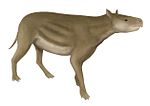 | ||
| 38—33.9 | Род: | Древнейший известный canid. |  | ||
| ??? | Род: | Древнейший известный lagomorph. | |||
| 52.5 | Род: | One of the two oldest known monospecific genera of bat. | |||
| 2 | Species: | Древнейший известный member of the giant panda clade. | |||
| 63 - 61.7Ma | Род: | Believed to be the earliest example of a primate or a proto-primate, a primatomorph precursor to the Plesiadapiformes. |  | ||
| 12.5-8.5 | Род: | This genusy have been the ancestor to the modern orangutans. |  | ||
| 16 - 8 | Род: | Вероятный предок of living hippopotamids. | |||
| ?? | Род: | Древнейший известный true (and scaled) pangolin. |  | ||
Early artiodactylans to whales (evolution of whales)
править| Эволюционная линия whale[англ.] | |||||
|---|---|---|---|---|---|
| Возраст, млн.лет | Таксон | Отношения | Статус | Описание | Фото |
| 55.8 ± 0.2 - 33.9 ± 0.1 | Род: |  | |||
| 50 | Род: |  | |||
| 46 | Род: |  | |||
| 47 | Род: | ||||
| 41-33 | Род: |  | |||
| 25 | Род: |  | |||
| 40-34 | Род: |  | |||
| 8-15 | Род: |  | |||
| 26 | Род: | ||||
| Эволюционная линия Sirenia[англ.]* | |||||
|---|---|---|---|---|---|
| Возраст, млн.лет | Таксон | Отношения | Статус | Описание | Фото |
| 50 | Род: | Примитивный sirenian. |  | ||
| 40 | Род: | ||||
| ??? | Род: | ||||
| 48.6–33.9 | Род: | An evolutionary bridge between primitive land-dwelling sirenians to aquatic sirenians |  | ||
| ??? | Род: | ||||
Evolution of the pinnipeds
править| Эволюционная линия Pinniped[англ.] | |||||
|---|---|---|---|---|---|
| Возраст, млн.лет | Таксон | Отношения | Статус | Описание | Фото |
| 21 to 24 | Род: | Древнейший известный pinniped. | |||
| ??? | Род: | A very basal pinniped. |  | ||
| 24-22 | Род: | An early seal, but with more primitive skull and feet. | |||
| Эволюционная линия Hyracotherium[англ.]* → Equus[англ.] | |||||
|---|---|---|---|---|---|
| Возраст, млн.лет | Таксон | Отношения | Статус | Описание | Фото |
| 60-45 | Род: |  | |||
| 40-30 | Род: |  | |||
| 20 | Род: |  | |||
| 17-11 | Род: |  | |||
| 12 | Род: |  | |||
| 1.8-0 | Род: |  | |||
| Эволюционная линия Человек | |||||
|---|---|---|---|---|---|
| Возраст, млн.лет | Таксон | Отношения | Статус | Описание | Фото |
| 36-32 | Род: | The oldest primitive monkey known in the fossil record, dating back before the split between Old and New world monkeys. | Basal to both Old and New world monkeys. | Primitive traits
Derived traits
| |
| 33 | Genus | A Miocene monkey which bridges the gap between the Eocene ancestors of Old world monkeys and Miocene ancestor of Hominoidea. | Tentatively positioned transitional form prior to the Old world monkey/ape split. | Primitive traits
Derived traits
|  |
| 27-14 | Genus | This primate exhibits very ape-like features like its teeth, but much of its post-cranial remains are more similar to monkeys. | Universally accepted to be intermediate between 'ape-like monkeys' such as Aegyptopithecus and later apes including hominids. | Primitive traits
Derived traits
|  |
| 13 | Род: | A European ape which is considered to be the predecessor of the great apes. | Some objections have been raised to this fossils status due to its location in Spain, but Pierolapithecus is likely a transitional taxon between generalized apes and the lineage which led to great apes. | Pleisomorphic traits
Derived traits
| |
| 4.4 | Род: | A woodland hominid adapted to quadruped arboreal locomotion, but also for bipedalism. | Intermediate between the last common ancestor of chimps and humans, and the australopithecines. | Primitive traits
Derived traits
|  |
| 4.4-2.0 | Род: | First known genus of fully bipedal apes which are probably ancestral to robust australopiths and the genus Homo[англ.]*. | Intermediate between extinct quadrupedal and bipedal apes. While the relationship between some species are being revised, Australopithecus afarensis[англ.]* is considered to be, by most experts, the ancestor to all later hominids. | Primitive traits
Derived traits
|  |
| 2.3-1.4 | Вид: | An early human which is the morphological link between australopithecines and later human species. | Perfect intermediate between early hominids and later humans, possibly ancestral to modern humans. | Primitive traits
Derived traits
|  |
| 2.0-1.0 | Species: | Very successful hominid, which was probably ancestral to both modern humans and neanderthals. Probably the first hominid to leave and successfully colonize territories outside of Africa. | Ancestral to modern humans and neanderthals. | Primitive traits
Derived traits
|  |
| 500 Ka-recent | Species | Homo rhodesiensis was the immediate ancestor of modern humans which evidently displaced the neanderthals in Europe and the island 'hobbits' of southeast Asia. H. rhodesiensis evolved from Homo erectus[англ.]* about half a million years ago but still retains some primitive characteristics such as relatively thick bones and molars larger than modern humans. | Ancestral to modern humans. | Primitive traits
Derived traits
|  |
See also
правитьReferences
править- ↑ Darwin, C (1859) On the Origin of Species. Chapter 10: On the Imperfection of the Geological Record.
- ↑ Weishampel D.B. (1996). "Fossils, Phylogeny, and Discovery: A Cladistic Study of the History of Tree Topologies and Ghost Lineage Durations". Journal of Vertebrate Paleontology. 16 (2): 191—197. doi:10.1080/02724634.1996.10011307. JSTOR 4523710.
- ↑ Shu D.-G., Morris S. Conway, Han J., Zhang Z.-F., Yasui K., Janvier P., Chen L., Zhang X.-L., Liu J.-N., Li Y., Liu H.-Q. Head and backbone of the Early Cambrian vertebrate Haikouichthys // Nature. — 2003. — 30 января (т. 421, № 6922). — С. 526—529. — ISSN 0028-0836. — doi:10.1038/nature01264.
- ↑ Ahlberg, Per Erik. Major events in early vertebrate evolution: palaeontology, phylogeny, genetics, and development. — Washington, DC : Taylor & Francis, 2001. — P. 188. — ISBN 978-0-415-23370-5.
- ↑ Zhu, M.; Zhao, W.; Jia, L.; Lu, J.; Qiao, T.; Qu, Q. (2009). "The oldest articulated osteichthyan reveals mosaic gnathostome characters". Nature. 458: 469—474.
- ↑ 1 2 3 4 5 Ahlberg, P. E. (1998). "Osteolepiforms and the ancestry of tetrapods" (PDF). Nature. 395 (6704): 792—794. Bibcode:1998Natur.395..792A. doi:10.1038/27421.
{{cite journal}}: Неизвестный параметр|coauthors=игнорируется (|author=предлагается) (справка) - ↑ 1 2 R. Cloutier. Taxonomic review of Eusthenopteron foordi. // Devonian Fishes and Plants of Miguasha, Quebec, Canada. — Dr. Friedrich Pfeil, München, 1996. — P. 487–502.
- ↑ Nature: The pelvic fin and girdle of Panderichthys and the origin of tetrapod locomotion
- ↑ Carroll, R. (1995). "Between fish and amphibians". Nature. 373: 389—390.
- ↑ Brazeau, M.D.; Ahlberg, P.E. (2006). "Tetrapod-like middle ear architecture in a Devonian fish". Nature. 439 (7074): 318—321. doi:10.1038/nature04196. PMID 16421569.
- ↑ John Noble Wilford, The New York Times, Scientists Call Fish Fossil the Missing Link, 5 April 2006.
- ↑ 1 2 Shubin, Neil. Your Inner Fish. — Pantheon, 2008. — ISBN 978-0-375-42447-2.
- ↑ Meet Your ancestor, the Fish that crawled. New Scientistgazine. Дата обращения: 7 февраля 2007.
- ↑ 1 2 Ahlberg, Per E. (1995). "Elginerpeton pancheni and the earliest tetrapod clade". Nature. 373 (6513): 420—425. Bibcode:1995Natur.373..420A. doi:10.1038/373420a0.
- ↑ Elginerpeton pacheni at Devonian Times Шаблон:WebCite
- ↑ 1 2 3 Ahlberg, Per. E. (26 Июнь 2008). "Ventastega curonica and the origin of tetrapod morphology". Nature. 453 (7199): 1199—1204. Bibcode:2008Natur.453.1199A. doi:10.1038/nature06991. PMID 18580942.
{{cite journal}}: Неизвестный параметр|coauthors=игнорируется (|author=предлагается) (справка) article - ↑ Clack, J. (21 Ноябрь 2005). "Getting a leg up on land". Scientific American. Архивировано 4 ноября 2006.
{{cite journal}}: Cite journal требует|journal=(справка) - ↑ "Acanthostega gunneri," Devonian Times. Шаблон:WebCite
- ↑ Shubin, Neil. Your Inner Fish: A Journey Into the 3.5-Billion-Year History of the Human Body. — New York : Vintage, 2009. — ISBN 978-0-307-27745-9.
- ↑ Lebedev, O.A. (1984). "The first find of a Devonian tetrapod vertebrate in the USSR". Doklady Akademii Nauk SSSR. Palaeontology. 278: 1470—1473.
- ↑ Gordon, M.S.; Long, J.A. (2004). "The Greatest Step In Vertebrate History: A Paleobiological Review of the Fish-Tetrapod Transition" (PDF). Physiological and Biochemical Zoology. 77 (5): 700—719.
- ↑ Clack, J. A. (2002). "An early tetrapod from 'Romer's Gap'". Nature. 418 (6893): 72—76. doi:10.1038/nature00824. PMID 12097908.
- ↑ 1 2 Anderson, J. S.; Reisz, R. R.; Scott, D.; Fröbisch, N. B.; Sumida, S. S. (2008). "A stem batrachian from the Early Permian of Texas and the origin of frogs and salamanders". Nature. 453: 515—518. doi:10.1038/nature06865. PMID 18497824.
{{cite journal}}: Неизвестный параметр|author-separator=игнорируется (справка); Шаблон цитирования имеет пустые неизвестные параметры:|author-name-separator=(справка) - ↑ Estes, R., and O. A. Reig. (1973): The early fossil record of frogs: a review of the evidence. Pp. 11-63 In J. L. Vial (Ed.), Evolutionary Biology of the Anurans: Contemporary Research onjor Problems. University of Missouri Press, Columbia.
- ↑ Moss J.L. (1972). "The Morphology and phylogenetic relationship of the Lower Permian tetrapod Tseajaia campi Vaughn (Amphibia: Seymouriamorpha)". University of California Publications in Geological Sciences. 98: 1—72.
- ↑ Berman, D.S.; Sumida, S.S.; Lombard, R.E. (1992). "Reinterpretation of the temporal and occipital regions in Diadectes and the relationship of diadectomorphs". Journal of Paleontology. 66: 481—499.
- ↑ 1 2 Gauthier J., Kluge, A.G., & Rowe, T. (1988) The early evolution of the Amniota. In: M. J. Benton (ed.) The phylogeny and classification of the tetrapods, Volume 1: amphibians, reptiles, birds (1): pp 103-155. Oxford: Clarendon Press.
- ↑ Solenodonsaurus on the TOL-web
- ↑ R. L. Paton, T. R. Smithson and J. A. Clack, "An amniote-like skeleton from the Early Carboniferous of Scotland", (abstract), Nature 398, 508-513 (8 April 1999)
- ↑ Fossilized Snake With Two Legs Found - Science - redOrbit. Дата обращения: 16 апреля 2008.
- ↑ Blogspot.com
- ↑ Wordpress.com
- ↑ Nesbitt, S.J. (2010). "Ecologically distinct dinosaurian sister group shows early diversification of Ornithodira". Nature. 464 (7285): 95—98. Bibcode:2010Natur.464...95N. doi:10.1038/nature08718. PMID 20203608.
{{cite journal}}: Неизвестный параметр|coauthors=игнорируется (|author=предлагается) (справка) - ↑ Langer, M.C. (2004). Basal Saurischia. In: Weishampel, D.B., Dodson, P., and Osmólska, H. (eds.). The Dinosauria (second edition). University of California Press:Berkeley, 25-46. ISBN 0-520-24209-2
- ↑ Galton, P.M. (2000). "Are Spondylosoma and Staurikosaurus (Santaria Formation, Middle-Upper Triassic, Brasil) the oldest saurischian dinosaurs?". Palaontologische Zeitschrift. 74 (3): 393—423.
- ↑ R.N.rtinez et al. A basal dinosaur from the dawn of the dinosaur era in southwestern Pangaea. Science, Vol. 331, 14 January 2011, p. 206.
- ↑ Kaplan M, "Move over Eoraptor", http://www.nature.com/news, 13-1-2011.
- ↑ Apaldetti, C; rtinez, RN; Alcober, OA; Pol, D (2011). "A New Basal Sauropodomorph (Dinosauria: Saurischia) from Quebrada del Barro Formation (Marayes-El Carrizal Basin), Northwestern Argentina". PLoS ONE. 6 (11): e26964. doi:10.1371/journal.pone.
{{cite journal}}: Википедия:Обслуживание CS1 (не помеченный открытым DOI) (ссылка) - ↑ Padian, K. & Chiappe, L.M. (1997): Bird Origins. In: Encyclopedia of Dinosaurs (red. Currie, P.J & Padian, K., Academic Press, San Diego, pp 41–96, ISBN 978-0-12-226810-6
- ↑ Chinsamy A.,rtin L.D., Dobson P. (1998). "Bone microstructure of the diving Hesperornis and the volant Ichthyornis from the Niobrara Chalk of western Kansas". Cretaceous Research. 19 (2): 225—235. doi:10.1006/cres.1997.0102.
{{cite journal}}: Википедия:Обслуживание CS1 (множественные имена: authors list) (ссылка) - ↑ "A new basal sphenacodontid synapsid from the Late Carboniferous of the Saar-Nahe Basin, Germany" (PDF). Acta Palaeontologica Polonica. 56 (1): 113—120. 2011. doi:10.4202/app.2010.0039.
{{cite journal}}: Источник использует устаревший параметр|authors=(справка) - ↑ 1 2 "Re-evaluation of Cutleria wilmarthi, an Early Permian synapsid from Colorado". Journal of Vertebrate Paleontology. 14 (1): 134—138. 1994.
{{cite journal}}: Источник использует устаревший параметр|authors=(справка) - ↑ Romer, A.S. (1940). "Review of the Pelycosauria". Special Papers of the Geological Siciety of America. 28: 1—538.
{{cite journal}}: Неизвестный параметр|coauthors=игнорируется (|author=предлагается) (справка) - ↑ GA Floridesa, Kalogiroua SA; SA; Wrobelb, L Tassoub (2001). "Natural environment and thermal behavior of Dimetrodon limbatus"". Journal of Thermal Biology. 26 (1): 15—20.
{{cite journal}}: Неизвестный параметр|author-separator=игнорируется (справка); Шаблон цитирования имеет пустые неизвестные параметры:|author-name-separator=(справка) - ↑ Kenneth D. Angielczyk, Dimetrodon Is Not a Dinosaur: Using Tree Thinking to Understand the Ancient Relatives ofmmals and their Evolution Evolution: Education and Outreach, Volume 2, Number 2, 257-271, doi:10.1007/s12052-009-0117-4
- ↑ 1 2 White, T. & Kazlev, M. A. (2009): Therapsida: Biarmosuchia: Biarmosuchidae / Eotitanosuchidae, from Palaeos website.
- ↑ Ruben, J.A. The Evolution ofmmalian Endothermy // Forerunners ofmmals. — Bloomington : Indiana University Press, 2011. — P. 272–286. — ISBN 0-253-35697-0.
- ↑ Maier, W. (27 апреля 2009). "New therapsid specimens and the origin of the secondary hard and soft palate ofmmals". Journal of Zoological Systematics and Evolutionary Research. 34 (1): 9—19. doi:10.1111/j.1439-0469.1996.tb00805.x.
{{cite journal}}: Неизвестный параметр|coauthors=игнорируется (|author=предлагается) (справка) - ↑ "A Jurassic eutherianmmal and divergence ofrsupials and placentals". Nature. 476 (7361): 442—445. 25 Август 2011. Bibcode:2011Natur.476..442L. doi:10.1038/nature10291.
{{cite journal}}: Источник использует устаревший параметр|authors=(справка) Electronic supplementaryterial
External links
править- Vuletic.com, Section V: Paleontology – Transitional fossils between every animal group
- Palaeos.com, Palaeos vertebrates starting with lobe-finned fish (very comprehensive)
- Talk.origins.org, FAQ: Transitional vertebrate fossils
- (A few) transitional fossils










